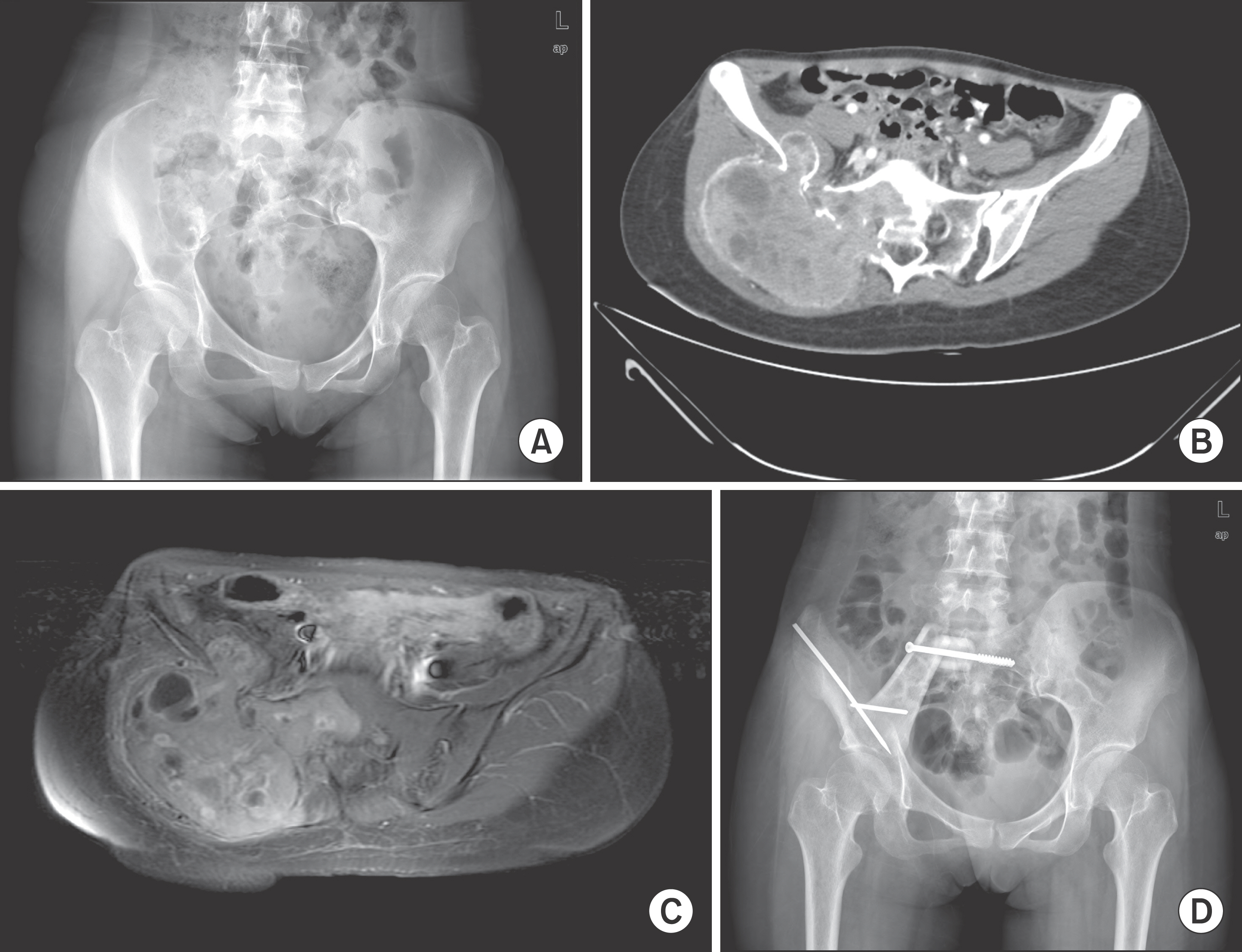J Korean Bone Joint Tumor Soc.
2013 Dec;19(2):43-49. 10.5292/jkbjts.2013.19.2.43.
Treatment Outcomes of Sacral Giant Cell Tumor
- Affiliations
-
- 1Department of Orthopedic Surgery, Korea Cancer Center Hospital, Seoul, Korea. wssongmd@gmail.com
- 2Department of Pathology, Korea Cancer Center Hospital, Seoul, Korea.
- KMID: 1961756
- DOI: http://doi.org/10.5292/jkbjts.2013.19.2.43
Abstract
- PURPOSE
We analyzed the treatment outcomes of patients with sacral giant cell tumor.
MATERIALS AND METHODS
We retrospectively reviewed 7 patients with giant cell tumor of the sacrum who were treated at out institution between 1990 and 2012.
RESULTS
There were 2 men and 5 women with mean age of 23.6 years. The average follow up was 52.3 months (range, 15-73 months). Six patients received surgical treatment. Intralesional curettage was performed for the 5 patients and marginal resection for another one patient. The remaining one patient was received radiation only. The patients who received radiation therapy and marginal excision had no residual or recurrent tumors. Of 5 patients with intra-lesional excision, one patient needs one more operation; two patients need two more operation for local control of the giant cell tumor. The remaining two patients failed to gain local control in spite of additional treatments.
CONCLUSION
For the treatment of sacral giant cell tumor, intralesional resection can be one of the treatments option with minimal neurologic injury. Furthermore, radiation therapy can be recommended when complete excision or curettage is impractical.
Keyword
MeSH Terms
Figure
Reference
-
References
1. Sung HW, Shu WP, Wang HM, Yuai SY, Tsai YB. Surgical treatment of primary tumors of the sacrum. Clin Orthop Relat Res. 1987; 215:91–8.
Article2. Turcotte RE. Giant cell tumor of bone. Orthop Clin North Am. 2006; 37:35–51.
Article3. Campanacci M, Baldini N, Boriani S, Sudanese A. Giant-cell tumor of bone. J Bone Joint Surg Am. 1987; 69:106–14.
Article4. Feigenberg SJ, Marcus Jr RB, Zlotecki RA, Scarborough MT, Berrey BH, Enneking WF. Radiation therapy for giant cell tumors of bone. Clin Orthop Relat Res. 2003; 411:207–16.
Article5. McDonald DJ, Sim FH, McLeod RA, Dahlin DC. Giant-cell tumor of bone. J Bone Joint Surg Am. 1986; 68:235–42.
Article6. Sung HW, Kuo DP, Shu WP, Chai YB, Liu CC, Li SM. Giantcell tumor of bone: analysis of two hundred and eight cases in Chinese patients. J Bone Joint Surg Am. 1982; 64:755–61.7. Guo W, Ji T, Tang X, Yang Y. Outcome of conservative surgery for giant cell tumor of the sacrum. Spine (Phila Pa 1976). 2009; 34:1025–31.
Article8. Leggon RE, Zlotecki R, Reith J, Scarborough MT. Giant cell tumor of the pelvis and sacrum: 17 cases and analysis of the literature. Clin Orthop Relat Res. 2004; 423:196–207.9. Thangaraj R, Grimer RJ, Carter SR, Stirling AJ, Spilsbury J, Spooner D. Giant cell tumour of the sacrum: a suggested algorithm for treatment. Eur Spine J. 2010; 19:1189–94.
Article10. Martin C, McCarthy EF. Giant cell tumor of the sacrum and spine: series of 23 cases and a review of the literature. Iowa Orthop J. 2010; 30:69–75.11. Rock MG, Sim FH, Unni KK, et al. Secondary malignant giantcell tumor of bone. Clinicopathological assessment of nineteen patients. J Bone Joint Surg Am. 1986; 68:1073–9.
Article12. Laskin WB, Silverman TA, Enzinger FM. Postradiation soft tissue sarcomas. An analysis of 53 cases. Cancer. 1988; 62:2330–40.
Article13. Dray MS, Miller MV. Paget's osteosarcoma and post-radiation osteosarcoma: secondary osteosarcoma at Middlemore Hospital, New Zealand. Pathology. 2008; 40:604–10.
Article14. Kong CB, Hong YS, Lee KY, et al. Malignant transformation of benign giant cell tumor. J Korean Bone Joint Tumor Soc. 2012; 18:14–9.
Article15. Lackman RD, Khoury LD, Esmail A, Donthineni-Rao R. The treatment of sacral giantcell tumours by serial arterial embolisation. J Bone Joint Surg Br. 2002; 84:873–7.
Article16. Hosalkar HS, Jones KJ, King JJ, Lackman RD. Serial arterial embolization for large sacral giantcell tumors: mid- to longterm results. Spine (Phila Pa 1976). 2007; 32:1107–15.17. Bertoni F, Present D, Sudanese A, Baldini N, Bacchini P, Campanacci M. Giant-cell tumor of bone with pulmonary metastases. Six case reports and a review of the literature. Clin Orthop Relat Res. 1988; 237:275–85.18. Thomas D, Henshaw R, Skubitz K, et al. Denosumab in patients with giantcell tumour of bone: an open-label, phase 2 study. Lancet Oncol. 2010; 11:275–80.
Article19. Branstetter DG, Nelson SD, Manivel JC, et al. Denosumab induces tumor reduction and bone formation in patients with giantcell tumor of bone. Clin Cancer Res. 2012; 18:4415–24.
Article





